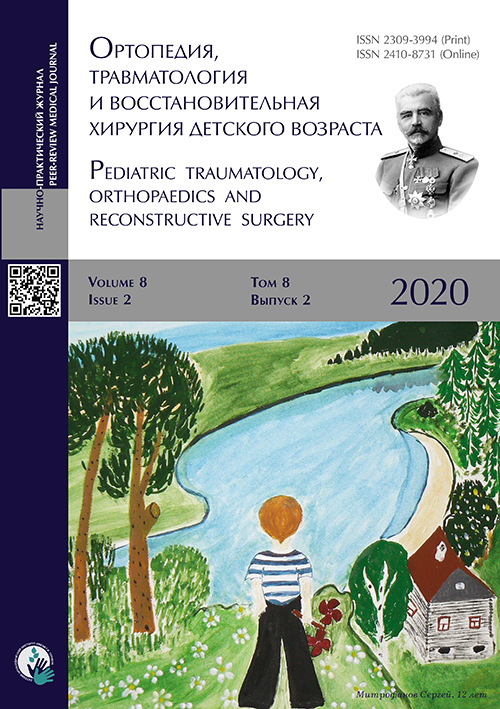儿童外伤性双侧后髋关节脱位:一例12年随访病例报告
- 作者: Soto-Juárez I.1, Martínez-Pérez R.1
-
隶属关系:
- Centenario Hospital Miguel Hidalgo
- 期: 卷 8, 编号 2 (2020)
- 页面: 213-216
- 栏目: Clinical cases
- ##submission.dateSubmitted##: 22.10.2019
- ##submission.dateAccepted##: 10.02.2020
- ##submission.datePublished##: 01.07.2020
- URL: https://journals.eco-vector.com/turner/article/view/16543
- DOI: https://doi.org/10.17816/PTORS16543
- ID: 16543
如何引用文章
详细
背景。儿童双侧外伤性髋关节脱位在骨科急诊中十分罕见。现有文献中很少有相关病例报告。
临床病例。本文呈现了1例轻微损伤机制的4岁男童病例。受伤24小时后在急诊科完成闭合复位。他接受了4天的Buck皮肤牵引,人字形石膏固定4周。在随访期间,患者至骨骼成熟时无任何临床症状或早晚期并发症。
讨论。小儿髋关节脱位是一种罕见的急症,其发病率为每年百万分之0.8例。为了尽量减少晚期并
发症,如骨坏死、复发性脱位、骨关节炎、神经病变、大头髋畸形及异位骨化,不应延迟其治疗。
报道的髋关节骨坏死的发生率为晚期复位(>6小时)36.4%,早期复位(<6小时)8.2%。尽管在24小时后才完成复位,但12年随访期间未出现并发症。
结论。在立即复位后固定4至6周的治疗是有效的。必须进行密切监测,及时发现并治疗任何进一步的并发症。
全文:
儿童创伤性髋关节脱位是一种少见的
病变,在儿童脱位中占比低于5%,以男童
居多[1, 2]。根据其表现,创伤性髋关节脱位可以为前髋关节或后髋关节脱位,单侧或双侧髋关节脱位。虽然对治疗时机及其对预后的影响仍有争议,但众所周知,因晚期复位的病例预后不佳,且并发症诸如缺血性坏死、大头髋畸形、异位骨化、复发性脱位或骨关节炎的发生率更高,故应立即对髋关节脱位进行诊断和治疗。这些并发症可出现在早期或晚期,所以应对患者进行长期密
切监测。
本文呈现了一例非常罕见的病例,一名男童因低能量机制发生外伤性双侧后髋关节脱位。受伤24小时后接受晚期闭合复位治疗后恢复。对该患者进行密切随访,直至其骨骼成熟,未发生任何并发症。
临床病例
1例4岁男童,无相关临床病史,在农场从骡车上跌落24小时后来到急诊科就诊。其双髋关节疼痛、畸形、功能受限。据父
母说,因为在原住城镇内无法立即得到专门的医疗照顾,并且缺少紧急转移的资金,
治疗受到延误。
在临床检查中,双髋关节内收内旋,
双膝弯曲,表现为左膝擦伤和瘀斑,可触摸到双臀隆起。未发现远端神经血管损伤的临床资料。
行X线,显示双髋股关节不协调,双股骨头后侧移位,骨连续性未见改善(图1)。
图 1。骨盆骨头的初级放射照片。在前后投影中,可以看到hip关节的双侧后位移(a);脱位后立即消除X射线。骨盆从臀部恢复关节(b)
受伤后24小时诊断为创伤性双侧髋关节脱位。
于急诊室进行闭合复位,双髋90度屈曲牵引外旋。在新X线结果表明复位后,对双下肢分别进行1公斤重的Buck皮肤牵引,
持续4天。第4天去除双侧牵引,放置人字形石膏,髋部15度外拐,膝关节15度屈曲。
患儿入院后6天出院,4周后在门诊去除石膏并进行评估。发现双髋弓可完全活动,同时开始物理治疗,两周后完全负重。
12个月后,患者无症状,无移动弧
限制,日常活动和玩耍无限制(图2)。
图 2。骨盆骨的x射线后12个月的观察(a); 最后的对照X射线。骨盆经12年观察, 达到骨成熟(b)
伤后随访12年,16岁患者独立行走,
无跛行;完全移动弧,骨盆摄片未显示任何异常。
讨论
小儿髋关节脱位是一种罕见的急症,
其发病率为每年百万分之0.8例,为了减少晚期并发症,不应延迟其治疗;最常见的并发症为骨坏死,发生率为3至15%,如果未在最初6小时内复位,发生率则会增加
20倍[3, 4]。其他报道的晚期并发症包括复发性脱位、骨关节炎、神经损伤(见于5%的儿童);大头髋畸形(26%)和异位骨化。
然而,在儿童既往健康的髋关节出现双侧髋关节脱位更为罕见,没有其发生率的报道,也很少有病例报告。此外,目前还没有截至骨骼成熟的随访报告。在Pubmed平台上搜索关键词:<双侧>、<外伤性>、<髋关节>、
<脱位>和<儿童>,我们得到了13个结果,其中只有5篇出版文献是真正的儿童创伤性双侧髋关节脱位英文病例报告[5-9],只有4篇为同时双侧损伤。
在本例中,双侧髋关节脱位是由于轻微机制造成的。所公认的是,造成该损伤所需的力量随着年龄的增长而增加。对于10岁以下的儿童,由于髋臼周围结构松弛,低能量的力量就足够造成损伤,同时也有助于降低相关骨折的发生率。在Mehlman 和cols回顾的所有病例中,脱位都属后位脱位。然而,也有文献包含低能量机制导致单侧前位脱位的报道[10]。
由于原社区到医院的距离较远以及其他经济问题,从受伤到复位的间隔时间为24小时。关于复位时间存在争议,
Mehlman等人所做的系列研究报告称,在受伤超过6小时后复位的患者发生缺血性坏死的风险增加20倍。然而,
在Bunell和Webster所做的研究中,在5周后对一名5岁女童既往健康的髋关节行复位,未发生晚期并发症。在一项成人和儿童混合人群荟萃分析中,比较复
位时间和股骨头缺血性坏死的发生,
晚期复位(>6小时)和早期复位(<6小时)
的股骨头缺血性坏死发生率分别为36.4%和8.2%;这意味着髋关节脱位与复位的时间间隔大于6小时的患者发生缺血性坏死的概率比为7.44[11]。
对于那些一般因无意脱位超过三周而出现挛缩的患者,在三次尝试闭合复位失败后实施开放复位。应考虑切开长收肌并行腰肌延长,用克氏针固定。如果失败,
另一种选择是后路切开复位以避免股骨头进一步断流,这种方法对受伤超过6周的患者是有用的[12]。
患者必须在复位后接受固定。同样,
对于切开复位或闭合复位后的固定时间也没有共识。建议10岁以下儿童固定3至4周,
青少年和成人固定6至12周。在本病例中,
4周后去除人字形石膏,2周后开始完全
负重,因为根据Glass 和Powell的
建议[13],预计此时软组织正在愈合。
在随后的评估中,尽管在24小时后接受复位,患者无症状,影像学上无缺血性
坏死、大头髋畸形、异位骨化、复发性脱位或骨关节炎的征象。该结果与其他关于双侧髋关节脱位的报道相似,然而,在另一个搜索平台上,我们发现了1例14岁青少年因高能量机制导致双侧髋关节脱位的病例,
其在受伤22小时后接受复位。经过4年零
11个月的随访,报道患者出现缺血性坏死和继发性骨关节炎[14]。
双侧外伤性髋脱位在儿童中是一种非常罕见的骨科损伤,及时治疗并不能保证无并发症进展。一些相关的不良预后因素是儿童年龄
较大、高能量机制损伤、相关骨折和复位延迟。
结论
进行立即复位为优先选择。根据现有文献,
行闭合复位并固定4至6周是一种有效的治疗
措施。应告知父母上述风险和密切监测的重要性以及时发现并治疗任何进一步的并发症。
其它信息
资金来源。本研究未获得任何公共、
商业或非营利机构的专项奖学金。
利益冲突。无利益冲突。
伦理审查。以上资料均得到父母明确的学术许可和出版许可。
作者贡献
I. Soto-Juárez — 知识理念和整个研究项目的准备工作。
R. Martínez-Pérez — 撰写和修改,以及知识理念。
所有作者都对本研究和论文撰写做出了重大贡献,在发表前阅读并批准了最
终版本。
作者简介
Ignacio Soto-Juárez
Centenario Hospital Miguel Hidalgo
Email: ignaciosotojuarez@hotmail.com
ORCID iD: 0000-0001-8001-9227
MD, Orthopaedic and Trauma Surgeon, Pelvis and acetabulum specialist. Orthopaedics and Trauma Department
墨西哥, AguascalientesRicardo Martínez-Pérez
Centenario Hospital Miguel Hidalgo
编辑信件的主要联系方式.
Email: ortho.surgery.martinez@gmail.com
ORCID iD: 0000-0003-4386-1946
MD, Orthopaedic Surgery resident. Orthopaedics and Trauma Department
墨西哥, Aguascalientes参考
- Mootha AK, Mogali KV. A rare case of neglected traumatic anterior dislocation of hip in a child. J Orthop Case Rep. 2016;6(3):40-42. https://doi.org/10.13107/jocr.2250-0685.496.
- Stracciolini A, Yen YM, d’Hemecourt PA, et al. Sex and growth effect on pediatric hip injuries presenting to sports medicine clinic. J Pediatr Orthop B. 2016;25(4):315-321. https://doi.org/10.1097/BPB.0000000000000315.
- Sanders S, Tejwani N, Egol KA. Traumatic hip dislocation: a review. Bull NYU Hosp Jt Dis. 2010;68(2):91-96.
- Herrera-Soto JA, Price CT. Traumatic hip dislocations in children and adolescents: pitfalls and complications. J Am Acad Orthop Surg. 2009;17(1):15-21. https://doi.org/10.5435/00124635-200901000-00003.
- Garg V, Singh AP, Singh AP, Bajaj PS. Traumatic bilateral posterior hip dislocation in 10 year old male child. J Clin Orthop Trauma. 2014;5(3):154-156. https://doi.org/10.1016/j.jcot.2014.07.006.
- Sahin V, Karakas E, Turk, CY. Bilateral traumatic hip dislocation in a child: a case report and review of the literature. J Trauma. 1999;46(3):500-504. https://doi.org/10.1097/00005373-199903000-00028.
- Endo S, Yamada Y, Fujii N, et al. Bilateral traumatic hip dislocation in a child. Arch Orthop Trauma Surg. 1993;112(3):155-156. https://doi.org/10.1007/bf00449995.
- Bunell WP, Wesbster DA. Late reduction of bilateral traumatic hip dislocations in a child. Clin Orthop Relat Res. 1980;(147):160-163.
- Bernhang AM. Simultaneous bilateral traumatic dislocation of the hip in a child. J Bone Joint Surg Am. 1970;52(2):365-356.
- Mehlman CT, Hubbard GW, Crawford AH, et al. Traumatic hip dislocation in children long-term followup of 42 patients. Clin Orthop Relat Res. 2000;(376):68-79.
- Ahmed G, Shiraz S, Riaz M, Ibrahim T. Late versus early reduction in traumatic hip dislocations: a meta-analysis. Eur J Orthop Surg Traumatol. 2017;27(8):1109-1116. https://doi.org/10.1007/s00590-017-1988-7.
- Hung NN. Traumatic hip dislocation in children. J Pediatr Orthop B. 2012;21(6):542-551. https://doi.org/10.1097/BPB.0b013e328356371b.
- Glass A, Powell HDW. Traumatic dislocation of the hip in children. J Bone Joint Surg Br. 1961;43-B(1):29-37. https://doi.org/10.1302/0301-620x.43b1.29.
- Yaokreh JB, Serges YG, Ouattara O, Dick R. Bilateral traumatic symmetric posterior hip dislocation in a teenager. J Trauma Treat. 2016,5:280. https://doi.org/10.4172/2167-1222.1000280.
补充文件









